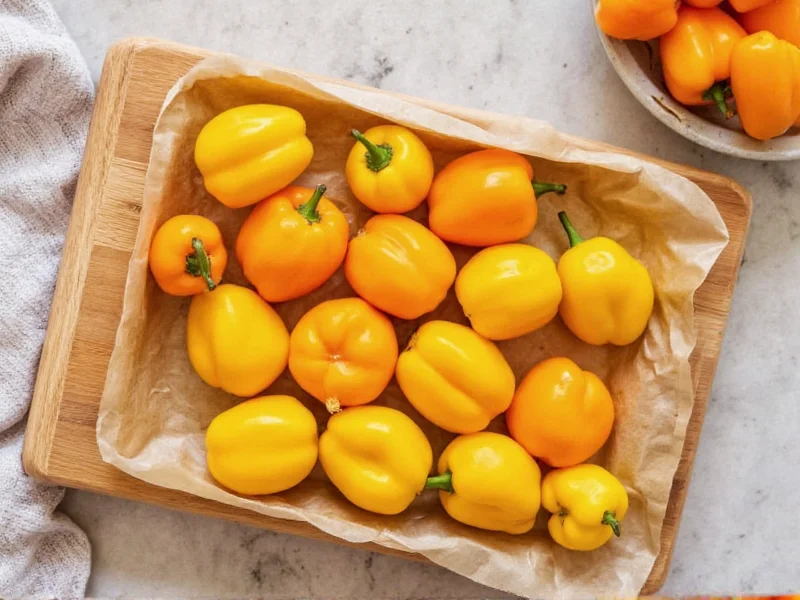Why Dehydrate Sweet Peppers?
Dehydrating sweet peppers transforms your garden surplus or market haul into a versatile pantry staple. Unlike hot peppers, sweet varieties like bell peppers, pimientos, and banana peppers contain no capsaicin, making their concentrated flavor perfect for soups, stews, and seasoning blends. The dehydration process removes approximately 90% of moisture, reducing weight and volume while preserving nutrients. Home-dehydrated peppers avoid the sulfites and preservatives found in commercial products, giving you complete control over quality.
Essential Equipment Options
Three practical methods work for dehydrating sweet peppers, each with specific advantages:
| Method | Temperature | Time Required | Best For |
|---|---|---|---|
| Food Dehydrator | 125°F (52°C) | 8-12 hours | Consistent results, energy efficiency |
| Oven Method | 145°F (63°C) | 6-10 hours | When dehydrator unavailable |
| Air Drying | Ambient | 2-3 weeks | Dry climates with low humidity |
Step-by-Step Preparation Guide
Select firm, blemish-free sweet peppers at their peak ripeness for optimal dehydration results. Red, yellow, and orange varieties contain more sugar and dehydrate better than green peppers. Wash thoroughly under cool running water, then pat completely dry with clean towels. Remove stems, seeds, and white membranes which retain moisture and can cause spoilage.
Slice peppers into uniform 1/4-inch thick pieces for consistent drying. Thicker slices require significantly longer dehydration time and risk uneven drying. For powder production, slice even thinner at 1/8-inch. Arrange slices in single layers with no overlapping on dehydrator trays or baking sheets. Proper air circulation prevents steaming and ensures even moisture removal.
Detailed Dehydration Methods
Using a Food Dehydrator (Recommended Method)
Arrange prepared pepper slices on dehydrator trays, leaving space between pieces. Set temperature to 125°F (52°C) - higher temperatures can cook rather than dry the peppers, destroying flavor compounds. Rotate trays every 4 hours for even drying. Check for doneness after 8 hours by removing a piece, letting it cool for 5 minutes, then bending. Properly dehydrated peppers should be brittle and snap cleanly when bent.
Oven Dehydration Technique
Preheat your oven to its lowest setting, ideally 145°F (63°C). Place pepper slices on wire racks over baking sheets to allow air circulation. Prop the oven door open 2-3 inches using a wooden spoon to maintain proper airflow and prevent moisture buildup. Rotate trays every 2 hours. Oven dehydration requires more attention as temperatures fluctuate more than dehydrators.
Testing for Complete Dryness
Improperly dried sweet peppers can develop mold during storage. To verify complete dehydration, perform these tests:
- The Snap Test: Cool a sample piece completely, then attempt to bend it. Properly dehydrated peppers should snap crisply.
- The Touch Test: Squeeze a piece firmly. No moisture should be released, and it shouldn't feel leathery.
- The Condensation Check: Place cooled peppers in a sealed jar for 12 hours. If condensation appears, return to dehydrator.
Proper Storage Techniques
Store completely cooled dehydrated peppers in airtight containers away from light and heat. Glass jars with oxygen absorbers preserve quality longest. For extended storage beyond 6 months, vacuum seal with moisture absorbers. Always label containers with date and pepper variety. Properly stored dehydrated sweet peppers maintain quality for 12-18 months.
Check stored peppers monthly for moisture signs. If you notice any softening or condensation, immediately return peppers to the dehydrator for additional drying time. Never store partially dehydrated peppers as this creates perfect conditions for mold growth.
Rehydration and Usage Tips
Reconstitute dehydrated sweet peppers by covering with hot water and soaking for 20-30 minutes until plump. Use the soaking liquid in recipes to capture flavor compounds. For powder, simply grind completely dry peppers in a spice grinder until fine.
Dehydrated sweet peppers excel in:
- Homemade seasoning blends and rubs
- Adding concentrated flavor to soups and stews
- Creating vibrant red pepper powder
- Emergency food storage with minimal space requirements
- Adding sweetness to tomato-based sauces
Troubleshooting Common Issues
Problem: Peppers remain leathery after recommended drying time
Solution: Increase drying time by 2-4 hours. Humidity affects drying time significantly.
Problem: Peppers develop mold during storage
Solution: Peppers weren't completely dry before storage. Return to dehydrator immediately.
Problem: Uneven drying with some pieces brittle while others remain soft
Solution: Slice peppers more uniformly next time and rotate trays more frequently.
Frequently Asked Questions
Can I dehydrate sweet peppers without a dehydrator?
Yes, you can use your oven on the lowest setting with the door propped open, or air dry peppers in very dry climates. Oven drying requires more attention to prevent cooking rather than drying, while air drying takes 2-3 weeks and works best in low-humidity environments below 60%.
How do I know when sweet peppers are properly dehydrated?
Properly dehydrated sweet peppers should be brittle and snap cleanly when bent. Perform the jar test by placing cooled peppers in a sealed container for 12 hours - if no condensation appears, they're sufficiently dry for storage.
What's the best way to store dehydrated sweet peppers long-term?
Store completely cooled peppers in airtight glass containers with oxygen absorbers in a cool, dark place. For maximum shelf life (12-18 months), vacuum seal with moisture absorbers. Always label containers with the date and pepper variety.
Why do my dehydrated sweet peppers turn brown during the process?
Browning occurs when peppers are exposed to temperatures that are too high, essentially cooking them rather than dehydrating. Maintain temperatures at or below 125°F (52°C) for sweet peppers to preserve color and nutrients while removing moisture effectively.
Can I dehydrate different colored sweet peppers together?
Yes, but be aware that red, yellow, and orange peppers contain more sugar and may require slightly longer drying times than green peppers. For consistent results, separate by color or check each color variety individually for doneness.











 浙公网安备
33010002000092号
浙公网安备
33010002000092号 浙B2-20120091-4
浙B2-20120091-4